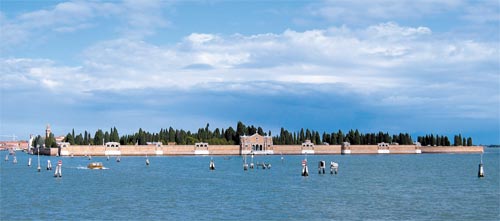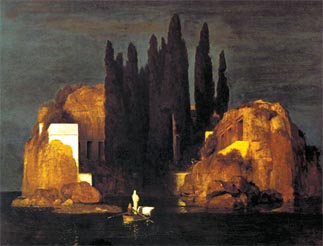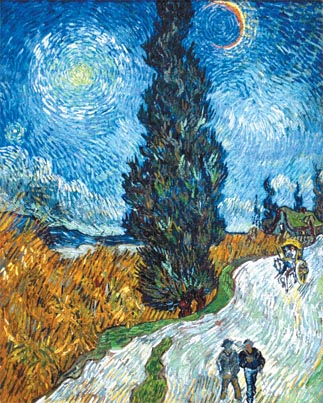The beautiful life in the trees of the dead

The island of San Michele viewed from Venice’s coast. Photo by Moon So-young
“Wow, the island seems to be filled with so many cypresses. The entire island must be a great garden, a garden belonging to an abbey or a royal villa,” I thought, recalling the fascinating trees that frequently appear in the paintings of Vincent Van Gogh (1853-1890).
Later I discovered that the beautiful island, San Michele, is actually a garden of the dead. The entire island is used as a cemetery for the city of Venice.
San Michele was designated as a cemetery in the early 19th century. Some say that the designation was given because Venice had fallen short of space for tombs and others say the area was chosen for its location away from the city, which could help prevent the germs of the deceased from spreading following an epidemic.
The cemetery is still in use today, and funeral processions for the people of Venice are held in the waters of the city’s canals. It’s quite a mystic scene to imagine, and it overlaps with the belief common in both Western and Asian cultures that the souls of the dead cross rivers to enter the next world.
The island of San Michele reminds me of the famous painting “Isle of the Dead” by Swiss symbolist artist Arnold Bocklin (1827-1901). In the painting, against a dark sky, the island’s yellowish rocks and the white surfaces of the buildings situated among them are lit by the slanted rays of the sun, creating a contrast that arouses eerie and uneasy feelings. From out of the black sea, which is as silent as the dead, a small rowboat moves slowly toward a gate on the island’s inner shore.
In the boat is an oarsman and a figure clad entirely in white, just like an Egyptian mummy, who stands upright just behind a coffin that is also painted white. The figure and the coffin shine in the waning sunlight, but will soon be absorbed by the shadows cast by the solemn cypress trees. What dominates this painting is the absolute silence it contains. It is a painting of “such a stillness that one would be awed by a knock on the door,” as Bocklin once said.

Isle of the Dead (1880), by Bocklin (1827-1901), Oil on canvas, 111x115 cm, Kunstmuseum, Basel, Switzerland
Bocklin was living in Florence, Italy, when he painted this. He is said to have been inspired by the “English cemetery” in the city. But I think he could also have been inspired by the island of San Michele.
Bocklin himself did not leave many explanations about the painting, so various interpretations have arisen. Some say that the oarsman is Charon, who ferries the souls of the dead across the river to the underworld in Greek mythology, and that the figure in white is the soul of a person who died recently. There are others who have pointed out that the painting was commissioned by a widow, which means that the figure in white could represent the widow while the white coffin carries her husband’s body. If that is true, the island is a graveyard just like San Michele is, rather than an otherworld. However, I think this painting’s charm is that it looks simultaneously like a graveyard and an otherworld.
The painting eventually became so popular that Bocklin painted four more versions of it. One of these was temporarily held by the notorious German dictator Adolf Hitler. Elsewhere, Sergei Rachmaninoff, the Russian-American composer, was so impressed by the painting that he composed a symphonic poem with the same title in 1908.
But why do both San Michele and Bocklin’s isle of the dead have Mediterranean cypresses on their grounds? It is said that cypresses were regarded as “mournful trees” by the ancient Greeks and Romans, who planted them in their graveyards. That tradition remains today, so there are many cemeteries in Southern Europe with cypress trees. It sounds somewhat strange that this evergreen tree, which soars toward the sky more powerfully than any other tree, is the one used in graveyards. Maybe the tree is planted near tombs as a prayer for the rebirth or resurrection of the deceased.
The Mediterranean cypress was also loved by the Dutch Post-impressionist painter Vincent Van Gogh. The tree appears in his masterpieces “The Road with Cypress and Star” and “The Starry Night,” as well as many other paintings. He wrote in a letter to his brother Theo in June 1889 that: “The cypresses are always occupying my thoughts .?.?. It is as beautiful of line and proportion as an Egyptian obelisk. And the green has a quality of such distinction.”

Road with a Cypress and a Star (1890), by Van Gogh (1853-1890), Oil on canvas, 92x73 cm, Rijksmuseum Kroller-Muller, Otterlo, Netherlands
In this way, Van Gogh’s cypresses are at once the trees of death and the trees of life, linking heaven and earth in a mythological concept of a tree that shows that life and death are one.
by Moon So-young [symoon@joongang.co.kr]
Related Korean Article
죽음과 삶을 잇는, 지상과 대지를 잇는 부활의 표식
문소영 기자의 대중문화 속 명화 코드 : 아름다운 죽음의 나무 사이프러스
지난 휴가에 이탈리아 베네치아의 한 해안 선착장에서 알록달록한 집들로 유명한 부라노 섬으로 가려고 바포레토(수상버스)를 기다리고 있을 때, 바로 앞바다에 있는 독특한 섬 하나가 눈에 들어왔다(사진 1). 섬 가장자리가 단정한 황갈색 담으로 둘러싸이고 담 너머로 짙은 초록색의 길쭉길쭉한 지중해 사이프러스 나무들이 우거져 있는 섬이었다.
‘빈센트 반 고흐(1853~90)의 그림에 자주 나오는 그 멋진 나무들이 한두 그루도 아니고 잔뜩 있다니, 저 섬 전체가 하나의 정원인 걸까? 옛 귀족의 별장이나 수도원에 딸린 정원일까?’ 섬의 정체에 대한 호기심이 솟아올랐다. 나중에 알고 보니 이 아름다운 섬, 산 미켈레(San Michele)는 죽은 사람들의 정원이었다. 섬 전체가 하나의 공동묘지인 것이다.
산 미켈레 섬은 19세기 초 베네치아 시민들의 공동묘지로 지정됐다. 본토의 무덤자리가 모자랐기 때문이었다고도 하고, 전염병으로 죽은 시신이 병을 퍼뜨리는 것을 막기 위해서였다고도 한다. 전통은 현대까지 이어져 여전히 공동묘지로 쓰인다고 한다. 그렇다면 베네치아인의 장례 행렬은 자연히 배를 타고 물을 건너가는 것일 텐데, 저승으로 가는 영혼은 강을 건너게 된다는 동서양 문화권에 공통적으로 있는 믿음과 겹쳐지니 정말 신비로운 모습일 것이다.
그러고 보니 산 미켈레 섬은 스위스의 상징주의(Symbolism) 화가 아르놀트 뵈클린(1827~1901)의 유명한 그림 ‘죽은 이들의 섬’(사진 2, 우리나라에서는 ‘죽음의 섬’으로 주로 번역된다)을 떠올리게 한다. 이 그림을 보면, 하늘은 폭풍이 지나간 직후 또는 폭풍 직전처럼 무거운 청동색을 띠고 있고, 기울어진 햇빛이 황갈색 암벽과 달걀색 건물 외벽을 유난히 환하게 비추어 기묘하고 불안한 대조를 이루고 있다. 검푸른 바다는 주검처럼 고요한 가운데, 배 한 척이 서서히 이 섬으로 향한다.
배를 젓는 사공 앞으로 미라처럼 온통 하얀 천으로 몸을 감싼 인물이 우뚝 서있고 그 앞에는 역시 하얀 천으로 감싸인 관이 놓여 있다. 그들은 최후의 햇빛을 받아 하얗게 빛나고 있지만 곧 장엄하고 음울한 사이프러스 나무의 그늘 속으로 빨려 들어갈 것이다. 이 그림을 지배하는 것은 무시무시할 정도로 절대적인 침묵이다. 작가인 뵈클린이 말한 대로 이 그림을 물끄러미 보고 있는 사람은 “노크 소리에도 소스라치게 놀랄 만한 고요”를 창출하는 그림인 것이다.
이 그림 속의 섬은 순전히 화가의 환상이라고 생각했었는데, 실제로 엄숙한 사이프러스 나무들이 지배하는 ‘죽은 이들의 섬’이 존재할 줄이야! 뵈클린은 이 그림을 그릴 때 피렌체에 살고 있었고 근처에 있는 ‘영국인 묘지’에서 직접적인 영감을 받았다고 하지만, 나는 바다에 떠 있는 묘지 산 미켈레 섬에서도 영감을 받았을 것이라고 생각한다.
뵈클린은 이 그림에 대해 많은 설명을 남기지 않았기 때문에 해석이 분분하다. 일설에 따르면 하얀 천으로 몸을 감싼 인물은 바로 죽은 자의 영혼이고, 뱃사공은 그리스 신화에서 망자를 저승으로 건네준다는 뱃사공 카론(Charon)이다. 하지만 다른 설에 따르면, 이 그림을 주문한 마리에 베르나라는 여인이 얼마 전 남편을 여의었기 때문에, 하얀 인물은 남편의 관을 안치하러 가는 여인이라는 것이다. 이 경우 이 섬은 저승이라기보다 묘지일 것이고 산 미켈레 섬과 더욱 비슷하게 된다. 하지만 그 두 가지가 모호한 것이, 즉 이 그림 속 섬이 묘지이면서도 현실세계의 묘지보다는 어떤 이계(異界)로 느껴진다는 것이, 이 그림의 매력일 것이다.
이 그림은 처음 발표됐을 때부터 대단한 인기를 얻어서 뵈클린은 같은 주제로 넉 장의 그림을 더 그릴 정도였다. 그중 하나는 악명 높은 독일 독재자 아돌프 히틀러가 한동안 소장하기도 했다. 러시아의 음악가 세르게이 라흐마니노프는 이 그림에 영감을 받아 1908년 동명의 교향시를 작곡했다.
독특한 공포영화 제작자로 이름 높은 미국의 발 루튼은 1945년 영화 ‘죽음의 섬(죽은 이들의 섬)’을 제작했다. 이 영화는 어느 고립된 섬에서 사람들이 하나 둘 전염병으로 죽어가면서 광기와 미신에 사로잡혀 가는 내용으로서, 뵈클린의 그림과 직접 관련은 없지만, 영화 초반에 보여주는 이 섬의 전경이 뵈클린의 그림과 거의 비슷하다.(사진 3)
그런데 왜 산 미켈레 섬과 뵈클린의 ‘죽은 이들의 섬’에는 사이프러스 나무가 우거져 있는 것일까? 사이프러스는 고대 그리스와 로마 시대부터 죽음을 애도하는 의미로 무덤가에 심어졌다고 한다. 그리고 그 전통이 계속 이어져 남유럽 묘지에는 대개 사이프러스가 있다. 그 어느 나무들보다도 힘차게 하늘로 솟아있는 상록수 사이프러스가 묘지용 나무라니 이상한 일이다. 어쩌면 재생과 부활을 기원하는 의미에서 그런 것인지도 모르겠다. 죽은 이들의 못다 한 꿈이 창공으로 솟아오르기를 바라면서 사이프러스를 무덤가에 심었을지도 모르겠다.
사이프러스는 반 고흐가 특히 사랑한 나무였다. 그의 걸작 ‘사이프러스와 별이 있는 길’(사진4)에도, ‘별이 빛나는 밤’에도, 그 밖에 수많은 생 레미 시절 명작들에도 사이프러스가 등장한다. 반 고흐는 1889년 생 레미에서 동생 테오에게 보낸 편지에서 이렇게 말했다. “사이프러스는 언제나 내 생각을 사로잡고 있어. (중략) 사이프러스는 선과 비례에서 이집트 오벨리스크만큼 아름답지. 그리고 그 초록색은 특출한 격이 있어.”
그가 그토록 ‘죽음의 나무’ 사이프러스를 열심히 그린 것은 1년 뒤 찾아올 자신의 권총 자살을 예감했기 때문은 아닐까. 하지만 반 고흐의 사이프러스 그림은 그 어떤 나무 그림들보다도 강렬한 생명력을 분출한다. 뵈클린의 그림에서 사이프러스 나무들이 심판자들처럼 딱딱하고 위엄 있게 서 있었다면, 반 고흐의 그림에서는 타오르는 불꽃처럼 꿈틀거리면서 지상의 에너지를 끌어올려 천상으로 솟구치게 만들어 대기와 별과 달까지 함께 약동하게 만든다. 고흐의 그림에서 사이프러스는 죽음의 나무인 동시에 삶의 나무다. 그것은 신화에서 하늘과 땅을 잇는 ‘우주목’인 동시에 죽음과 삶이 하나임을 보여주는 나무다.
*중앙데일리 경제산업팀 기자. 일상 속에서 명화 이야기를 찾는 것이 큰 즐거움이며, 관련 저술과 강의도 하고 있다.
한글 원문 읽기
죽음과 삶을 잇는, 지상과 대지를 잇는 부활의 표식
문소영 기자의 대중문화 속 명화 코드 : 아름다운 죽음의 나무 사이프러스
지난 휴가에 이탈리아 베네치아의 한 해안 선착장에서 알록달록한 집들로 유명한 부라노 섬으로 가려고 바포레토(수상버스)를 기다리고 있을 때, 바로 앞바다에 있는 독특한 섬 하나가 눈에 들어왔다(사진 1). 섬 가장자리가 단정한 황갈색 담으로 둘러싸이고 담 너머로 짙은 초록색의 길쭉길쭉한 지중해 사이프러스 나무들이 우거져 있는 섬이었다.
‘빈센트 반 고흐(1853~90)의 그림에 자주 나오는 그 멋진 나무들이 한두 그루도 아니고 잔뜩 있다니, 저 섬 전체가 하나의 정원인 걸까? 옛 귀족의 별장이나 수도원에 딸린 정원일까?’ 섬의 정체에 대한 호기심이 솟아올랐다. 나중에 알고 보니 이 아름다운 섬, 산 미켈레(San Michele)는 죽은 사람들의 정원이었다. 섬 전체가 하나의 공동묘지인 것이다.
산 미켈레 섬은 19세기 초 베네치아 시민들의 공동묘지로 지정됐다. 본토의 무덤자리가 모자랐기 때문이었다고도 하고, 전염병으로 죽은 시신이 병을 퍼뜨리는 것을 막기 위해서였다고도 한다. 전통은 현대까지 이어져 여전히 공동묘지로 쓰인다고 한다. 그렇다면 베네치아인의 장례 행렬은 자연히 배를 타고 물을 건너가는 것일 텐데, 저승으로 가는 영혼은 강을 건너게 된다는 동서양 문화권에 공통적으로 있는 믿음과 겹쳐지니 정말 신비로운 모습일 것이다.
그러고 보니 산 미켈레 섬은 스위스의 상징주의(Symbolism) 화가 아르놀트 뵈클린(1827~1901)의 유명한 그림 ‘죽은 이들의 섬’(사진 2, 우리나라에서는 ‘죽음의 섬’으로 주로 번역된다)을 떠올리게 한다. 이 그림을 보면, 하늘은 폭풍이 지나간 직후 또는 폭풍 직전처럼 무거운 청동색을 띠고 있고, 기울어진 햇빛이 황갈색 암벽과 달걀색 건물 외벽을 유난히 환하게 비추어 기묘하고 불안한 대조를 이루고 있다. 검푸른 바다는 주검처럼 고요한 가운데, 배 한 척이 서서히 이 섬으로 향한다.
배를 젓는 사공 앞으로 미라처럼 온통 하얀 천으로 몸을 감싼 인물이 우뚝 서있고 그 앞에는 역시 하얀 천으로 감싸인 관이 놓여 있다. 그들은 최후의 햇빛을 받아 하얗게 빛나고 있지만 곧 장엄하고 음울한 사이프러스 나무의 그늘 속으로 빨려 들어갈 것이다. 이 그림을 지배하는 것은 무시무시할 정도로 절대적인 침묵이다. 작가인 뵈클린이 말한 대로 이 그림을 물끄러미 보고 있는 사람은 “노크 소리에도 소스라치게 놀랄 만한 고요”를 창출하는 그림인 것이다.
이 그림 속의 섬은 순전히 화가의 환상이라고 생각했었는데, 실제로 엄숙한 사이프러스 나무들이 지배하는 ‘죽은 이들의 섬’이 존재할 줄이야! 뵈클린은 이 그림을 그릴 때 피렌체에 살고 있었고 근처에 있는 ‘영국인 묘지’에서 직접적인 영감을 받았다고 하지만, 나는 바다에 떠 있는 묘지 산 미켈레 섬에서도 영감을 받았을 것이라고 생각한다.
뵈클린은 이 그림에 대해 많은 설명을 남기지 않았기 때문에 해석이 분분하다. 일설에 따르면 하얀 천으로 몸을 감싼 인물은 바로 죽은 자의 영혼이고, 뱃사공은 그리스 신화에서 망자를 저승으로 건네준다는 뱃사공 카론(Charon)이다. 하지만 다른 설에 따르면, 이 그림을 주문한 마리에 베르나라는 여인이 얼마 전 남편을 여의었기 때문에, 하얀 인물은 남편의 관을 안치하러 가는 여인이라는 것이다. 이 경우 이 섬은 저승이라기보다 묘지일 것이고 산 미켈레 섬과 더욱 비슷하게 된다. 하지만 그 두 가지가 모호한 것이, 즉 이 그림 속 섬이 묘지이면서도 현실세계의 묘지보다는 어떤 이계(異界)로 느껴진다는 것이, 이 그림의 매력일 것이다.
이 그림은 처음 발표됐을 때부터 대단한 인기를 얻어서 뵈클린은 같은 주제로 넉 장의 그림을 더 그릴 정도였다. 그중 하나는 악명 높은 독일 독재자 아돌프 히틀러가 한동안 소장하기도 했다. 러시아의 음악가 세르게이 라흐마니노프는 이 그림에 영감을 받아 1908년 동명의 교향시를 작곡했다.
독특한 공포영화 제작자로 이름 높은 미국의 발 루튼은 1945년 영화 ‘죽음의 섬(죽은 이들의 섬)’을 제작했다. 이 영화는 어느 고립된 섬에서 사람들이 하나 둘 전염병으로 죽어가면서 광기와 미신에 사로잡혀 가는 내용으로서, 뵈클린의 그림과 직접 관련은 없지만, 영화 초반에 보여주는 이 섬의 전경이 뵈클린의 그림과 거의 비슷하다.(사진 3)
그런데 왜 산 미켈레 섬과 뵈클린의 ‘죽은 이들의 섬’에는 사이프러스 나무가 우거져 있는 것일까? 사이프러스는 고대 그리스와 로마 시대부터 죽음을 애도하는 의미로 무덤가에 심어졌다고 한다. 그리고 그 전통이 계속 이어져 남유럽 묘지에는 대개 사이프러스가 있다. 그 어느 나무들보다도 힘차게 하늘로 솟아있는 상록수 사이프러스가 묘지용 나무라니 이상한 일이다. 어쩌면 재생과 부활을 기원하는 의미에서 그런 것인지도 모르겠다. 죽은 이들의 못다 한 꿈이 창공으로 솟아오르기를 바라면서 사이프러스를 무덤가에 심었을지도 모르겠다.
사이프러스는 반 고흐가 특히 사랑한 나무였다. 그의 걸작 ‘사이프러스와 별이 있는 길’(사진4)에도, ‘별이 빛나는 밤’에도, 그 밖에 수많은 생 레미 시절 명작들에도 사이프러스가 등장한다. 반 고흐는 1889년 생 레미에서 동생 테오에게 보낸 편지에서 이렇게 말했다. “사이프러스는 언제나 내 생각을 사로잡고 있어. (중략) 사이프러스는 선과 비례에서 이집트 오벨리스크만큼 아름답지. 그리고 그 초록색은 특출한 격이 있어.”
그가 그토록 ‘죽음의 나무’ 사이프러스를 열심히 그린 것은 1년 뒤 찾아올 자신의 권총 자살을 예감했기 때문은 아닐까. 하지만 반 고흐의 사이프러스 그림은 그 어떤 나무 그림들보다도 강렬한 생명력을 분출한다. 뵈클린의 그림에서 사이프러스 나무들이 심판자들처럼 딱딱하고 위엄 있게 서 있었다면, 반 고흐의 그림에서는 타오르는 불꽃처럼 꿈틀거리면서 지상의 에너지를 끌어올려 천상으로 솟구치게 만들어 대기와 별과 달까지 함께 약동하게 만든다. 고흐의 그림에서 사이프러스는 죽음의 나무인 동시에 삶의 나무다. 그것은 신화에서 하늘과 땅을 잇는 ‘우주목’인 동시에 죽음과 삶이 하나임을 보여주는 나무다.
*중앙데일리 경제산업팀 기자. 일상 속에서 명화 이야기를 찾는 것이 큰 즐거움이며, 관련 저술과 강의도 하고 있다.
JoongAng daily Hot issue
- [MP3]Law barring sex under pretense of marriage ruled unconstitutional
- Rail strike disrupting operations nationwide
- Two Koreas jointly to visit foreign industrial sites
- Many multiplexes go up for auction
- Proposal reduces foreign language high school status
- Korea sweeps up at the AFC awards
- Trade union groups mull a joint strike
- Echoes of a colonial past
- Jang aims for a 4th title at weight lifting championship
- Thriller lays bare the secrets that we keep











with the Korea JoongAng Daily
To write comments, please log in to one of the accounts.
Standards Board Policy (0/250자)